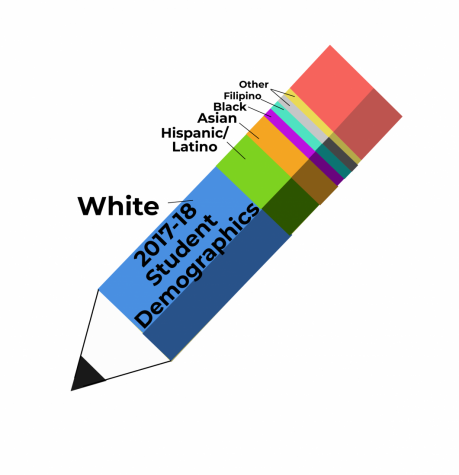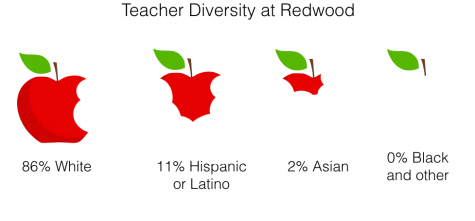Revisiting teacher segregation: a race to a solution
February 7, 2020
“Raise your hand if you have had any teachers of color, aside from me, in high school,” English teacher Catherine Flores asked her class. Only two students raised their hands.
Currently, 80 percent of teachers employed in U.S. public schools are white. While there has been a slight increase in racial diversity among teachers, the number of minority teachers is still low. According to data gathered by the Washington Post, only 7 percent of black students are enrolled in a district where the ratio of black teachers matches or exceeds the ratio of black students. Among Asian students, the ratio is 4.5 percent. Among Latino students, it is 0.1 percent.
Among white students, it is 99.7 percent.
Despite 80 percent of the American teacher population being white, only roughly half the student population is Caucasian. This is a remarkable decrease compared to the student population in 2000, where Caucasian students made up 62 percent of total students in the country. Ever since 2014, white students have been the minority group in American public schools compared to all students of color, according to the U.S. Department of Education, widening the gap between the racial make-up of students compared to teachers.
This heterogeneity stems from the Immigration and Nationality Act of 1965 and the now self-sustaining natural system of diversity. Despite such a dramatic change in demographics among students, teachers have not experienced a shift of the same magnitude.

At Redwood, 73.2 percent of students are white while the rest are minorities.
People of color are less likely to enter and remain in the profession of teaching for a variety of reasons. One in particular is the “invisible labor” that is required and often expected by teachers to keep up. According to Inside Higher Ed, a collegiate-focused media outlet, approximately 75 percent of black, Asian and Latino professors felt like they “needed to work harder than their colleagues to be seen as legitimate scholars.” This overtime work, especially without proper compensation, can often discourage minorities from pursuing a career in education.
Another root cause for the lack of minority teachers is potential bias in hiring practices if districts are placing an emphasis on hiring by race. Dr. Diane Whitmore Schanzenbach, a social policy and economics professor at Northwestern University, believes that this systemic bias inhibits the desired outcome through her research.
“[The indication] that qualified black teachers are not hired today just because of the color of their skin is crazy, and we should be having a conversation about that—not just about getting more African Americans to major in [education] and get a teaching certificate, but about our understanding of implicit bias in hiring,” Schanzenbach said.
Effect on student performance
There are several ramifications to the large disparity in race and ethnicity of students compared to teachers. In a survey conducted by Bark in January, 60 percent of black, Native American, Pacific Islander and Native Hawaiian students and 36 percent of Hispanic and Latino students self-reported that the lack of teacher racial diversity has negatively affected their learning experience. Conversely, only 14 percent of white students could say the same.
According to Dr. Seth Gershenson from American University and Dr. Nicholas Papageorge from Johns Hopkins University, when a black child has a black teacher between third and fifth grade, his or her eventual intent of attending a four-year college goes up by 19 percent, as reported from the IZA Labor Institute of Economics. According to this study, students are more successful in school if they have a teacher of the same ethnicity.
Research and intuitive sense suggest explanations for this phenomenon. One explanation is the “role model effect,” as Papageorge calls it, where seeing an individual that looks like oneself in a professional setting influences the level of education people aspire to achieve. In other words, if people directly interact with a successful individual, they believe they have those same possibilities and can reach similar achievements.
Based on his experiences in education, Assistant Superintendent and Head of Human Resources Lars Christensen supports this notion.
“I do think that seeing a successful person [of color] standing in front of [students] matters…I think it serves as motivation, like, ‘Hey, I can do that too.’ I think it definitely improves performance, [and for me], it’s anecdotal, but I believe with all my heart that it’s equally important for our large numbers of white students to see that,” Christensen said.
As a Latina teacher, Flores also carries this belief.
“If you’re constantly looking at white teachers, then your only association is with white people. And so you perhaps might start minimizing your abilities, or thinking ‘I can’t do this or I can’t do that’ because you’ve never seen an example for yourself,” Flores said.

The “Role Model Effect” is one possible explanation for why students benefit from learning from a teacher of their same race.
Another reason why students perform better with a teacher of the same race is the expectations of teachers. A study conducted by Dr. Patrick B. McGrady from the University of New Haven and Dr. John R. Reynolds from Georgia Institute of Technology found that white teachers tend to collectively view black students more negatively and Asian students more positively within a diversified classroom. These presumptions affect how teachers educate and discipline their students. Additionally, black students report that they feel happier at school, are more cared for by their teachers and have better communication when their teacher is also black.
According to Flores, a lack of racial diversity among teachers can lead to an ethnocentric mindset among students, which is detrimental to their future after high school.
“You need to be racially aware because these students are going to leave and they’re going to go to communities that aren’t necessarily extremely white. You need to know how to work with people and they’re going to work in jobs that aren’t one heterogeneous race,” Flores said.
Still, not all minority students have been affected by learning from someone who does not look like them. Senior Nikita Khandheria attended an Indian and International school in India before attending Redwood, and she does not feel inhibited by the almost all-white teaching staff she has had for the majority of her educational career. Rather than emphasize racial diversity among teachers, Khandheria prefers intellectual and experiential diversity.
“A lot of my teachers have been white, but they are all from different places…I feel like I’ve always gotten an experience where there is an integration of a lot of different cultures and types of people where nobody really thinks the same,” Khanderia said.
Changing student demographics
Despite 80 percent of the American teacher population being white, only roughly half the student population is Caucasian. This is a remarkable decrease compared to the student population in 2000, where Caucasian students made up 62 percent of total students in the country. Ever since 2014, white students have been the minority group in American public schools compared to all students of color, according to the U.S. Department of Education, widening the gap between the racial make-up of students compared to teachers.
This heterogeneity stems from the Immigration and Nationality Act of 1965 and the now self-sustaining natural system of diversity. Despite such a dramatic change in demographics among students, teachers have not experienced a shift of the same magnitude.

At Redwood, 73.2 percent of students are white while the rest are minorities.
People of color are less likely to enter and remain in the profession of teaching for a variety of reasons. One in particular is the “invisible labor” that is required and often expected by teachers to keep up. According to Inside Higher Ed, a collegiate-focused media outlet, approximately 75 percent of black, Asian and Latino professors felt like they “needed to work harder than their colleagues to be seen as legitimate scholars.” This overtime work, especially without proper compensation, can often discourage minorities from pursuing a career in education.
Another root cause for the lack of minority teachers is potential bias in hiring practices if districts are placing an emphasis on hiring by race. Dr. Diane Whitmore Schanzenbach, a social policy and economics professor at Northwestern University, believes that this systemic bias inhibits the desired outcome through her research.
“[The indication] that qualified black teachers are not hired today just because of the color of their skin is crazy, and we should be having a conversation about that—not just about getting more African Americans to major in [education] and get a teaching certificate, but about our understanding of implicit bias in hiring,” Schanzenbach said.
Teacher diversity at Redwood
The disproportionate relationship between teacher and student racial diversity applies to Redwood and the Tamalpais Union High School District (TUHSD) as well. During the 2017-2018 school year at Redwood, 86.1 percent of all teachers were white. There are currently zero black teachers at Redwood and only a few teachers of other ethnicities.
To address the lack of racial diversity on the teaching staff, the district wants to include more minorities early on in the recruitment process, according to Christensen.
“Having a greater appreciation for the challenges people of color have particularly in a pretty white society is helpful…Last year, [for] example, we went with an East Coast recruitment platform called Nemnet, and they specialize in attracting underrepresented candidates to various school districts. We were unsuccessful in securing any teachers through them, though,” Christensen said.

Currently, 85.7 percent of teachers at Redwood are Caucasian, and there are zero African American teachers at the school.
Even though the district is focusing on increasing racial diversity among its teachers, there are very few job openings and low financial resources.
“It is easier said than done, and we’re not hiding behind that. We are actively working to find ways to attract candidates to this area,” Christensen said. “There’s a certain level of discomfort by stepping into an affluent white community. You don’t like to think so, but that’s the reality, and we’re working on ways to overcome that.”
Special Education teacher and former Redwood student Faye Kwan experienced this discomfort when interviewing for a job for the TUHSD.
“I will say for me, coming back here, my interview was probably one of the most nerve-wracking interviews I’ve ever had. There was only one person of color on my panel of 12 people, and it really made me uncertain of how much I could be myself or what the racial consciousness was of this area,” Kwan said.
Some people, as Christensen used to, choose to be “colorblind” to provide an equal judgement toward all races. However, as he continues to learn new lessons every day and undergo racial consciousness training, he has found it more beneficial to see color.
“By quote, ‘not seeing color,’ I don’t think I was giving appropriate attention to the challenges that people of color face in this world society,” Christensen said. “But I’d be lying if I said [the racial diversity among teachers] has yet to completely translate into different numbers. The efforts are there, but the results aren’t.”
Beyond the classroom
While the correlation between teachers and students’ ethnicities is extremely prevalent in education, it expands further than the classroom. Other occupations in politics, law and STEM fields also exhibit similar impacts and discourage students from engaging in and pursuing certain areas of study.
Although there are occupations where African Americans and Latinos are overrepresented, those fields tend to be lower paying jobs, according to data compiled by the Census and the Bureau of Labor Statistics. While Asians are overrepresented in technology and medicine, they also have the fewest individuals in management positions of any race.

There are several industries that are overrepresented by a certain race outside of education as well.
One of the fundamental reasons for different races being disproportionately represented in certain fields is due to the systemic cycle of entering professions that seem familiar, and this is often derived by employees having similar appearances. According to Flores, if there is limited exposure in the first place, then it is difficult for individuals to enter certain fields.
An argument to address the racial gap by proportion is to hire by diversity, but there are concerns that this method would sacrifice merit and talent. Even when hiring teachers
Especially outside of racially and culturally homogeneous communities, diversity is becoming more prevalent in general. According to senior Kelly Chang, who attends Irvington High School with a vast majority Asian student body, being prepared for that change is important.
“I can say for my friends, some of my classmates and myself that we are kind of scared of what it’s like [outside of our current environment]. Most of us have stayed here since we were born,” Chang said. “Because we haven’t experienced having a mostly white population, we are kind of scared of that environment and of being alienated. That’s just not what we’re used to.”
